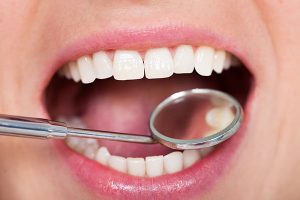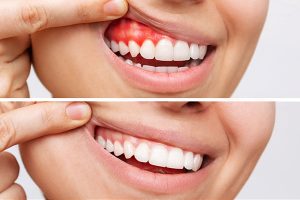Stages of Gum Disease in Luck, WI
Learn Gum Disease Stages for Better Prevention
Gum disease, also known as periodontal disease, is a hidden threat that can silently damage your gums and jawbone. If left untreated, it can lead to serious health problems. The good news is that gum disease is preventable and treatable, especially when caught early.
This guide from Luck Dental Clinic explores the different periodontal disease stages and their symptoms. By understanding the signs, you can take charge of your oral health and seek
professional help before it’s too late. To schedule an appointment, contact our top dentist in Luck, WI, by calling (715) 472-2211.
Gum Disease Stages
Gum disease, also known as periodontal disease, is a progressive infection that attacks the gums and bone supporting your teeth. Poor oral hygiene can create ideal conditions for harmful bacteria to thrive, leading to gum disease. It develops in stages, each with varying levels of severity. Here’s a breakdown of the stages:
Gingivitis
Gingivitis is the earliest and most reversible stage. It’s caused by plaque buildup along the gum line, leading to inflammation, redness, and bleeding gums. With good oral hygiene and professional cleanings, gingivitis can be fully reversed.
Early Periodontitis
If gingivitis is left untreated, it progresses to early periodontitis. The infection deepens into the gums and begins to affect the bone supporting the teeth. Symptoms may include persistent bad breath, bleeding gums, slight gum recession, and loose teeth. Scaling and root planing (deep cleaning) are the primary treatments at this stage.
Moderate Periodontitis
With further progression, bone loss becomes more significant, leading to deeper gum pockets, increased tooth mobility, and possible pain or discomfort while chewing. Treatment for moderate periodontitis may involve scaling and root planing, antibiotics to combat infection, and potentially surgical procedures like bone grafts or gum tissue regeneration to restore lost tissue.
Advanced Periodontitis
Advanced periodontitis, also known as advanced gum disease, is the most severe stage of gum disease characterized by extensive bone loss, significant tooth mobility, and potential tooth loss. Symptoms may include severe pain, pus discharge, and swollen or bleeding gums. Treatment focuses on managing the disease and preventing further tooth loss. It may involve advanced periodontal surgery, splinting of loose teeth, and potentially tooth extraction.
Detecting and Diagnosing Gum Disease

- Dental Exam: During a routine dental exam, your dentist will visually inspect your gums for signs of inflammation, redness, or bleeding. They will also measure gum pockets to assess the depth of the space between your gums and teeth.
- X-rays: Dental X-rays can reveal bone loss caused by gum disease, allowing the dentist to assess the severity of the condition.
Advanced periodontal disease, the final stage of gum disease, is characterized by severe bone loss, tooth mobility, and the potential need for tooth extraction. It is crucial to seek professional dental care to prevent severe health problems such as diabetes and heart attack.
Preventing Stages of Gum Disease From Progressing

- Brushing & Flossing: This powerful duo removes plaque, the breeding ground for gum-harming bacteria. Brush twice daily and floss once for a squeaky-clean victory.
- Regular Dental Checkups: Think of your dentist as your gum disease detective. They can spot early signs and recommend treatment before it advances.
- Healthy Habits: Smoking weakens gums and increases gum disease risk. Aim for a balanced diet for overall oral health.
Frequently Asked Questions
While more advanced stages of gum disease can’t be completely cured, they can be managed and controlled through proper oral hygiene practices and professional dental care. With early intervention, gingivitis (the earliest stage) can often be reversed, and the progression of gum disease can be slowed or stopped altogether.
Gum disease becomes irreversible in the second and third stages: early and moderate periodontitis. To avoid reaching these stages, maintaining good oral hygiene and visiting the dentist regularly for checkups and cleanings is crucial.
Yes, there’s growing evidence to suggest that gum disease may be linked to several systemic health conditions, including heart disease, stroke, and diabetes. This is because the bacteria that cause gum disease can enter the bloodstream and potentially cause inflammation throughout the body. Managing your gum health is crucial to maintaining your overall health and well-being.
Periodontal disease progresses gradually yet consistently. Plaque buildup can reach its peak within just four days, allowing visible signs of gingivitis to appear by day five. If gingivitis is left untreated, more advanced periodontal disease can manifest in a matter of weeks. Early detection and intervention can help prevent the rapid progression of gum disease.
Suspect You Have Gum Disease? Schedule a Consultation Today
Experiencing signs of gum disease, or simply want to prevent it altogether? Our dental practice in Luck is here to help. With years of experience in providing top-quality dental care, we have the expertise and knowledge to diagnose and treat early periodontitis effectively.
We offer comprehensive gum disease screenings and treatment plans tailored to your individual needs. Don’t wait until it’s too late. Schedule an appointment today by calling (715) 472-2211 and take the first step towards a healthier, happier smile! We welcome patients from Granstburg, Amery, and Milltown, WI.

